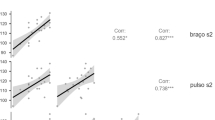Abstract
Background
Arterial hypertension is a common condition in older adults with increasing data about blood pressure (BP) targets and antihypertensive treatment in this population. Recent studies have opened new discussions about the different usual and unusual methods of blood pressure monitoring. However, there are no evidence-based recommendations whether BP should be measured at upper arms or at wrist, which seems to be more comfortable in older and frail people.
Aims
The purpose of this study was to test the quality of wrist BP monitors as diagnostic method in older adults.
Methods
BP measurements at both upper arms and at both wrists were compared under standardized conditions in 605 patients ≥ 75 years. Differences in wrist and upper arm BP were, furthermore, correlated with various diagnoses and parameters including ankle–brachial-index (ABI).
Results
In patients of 75–80 years, there were no differences in BP measurements at upper arms compared to wrists whereas in patients > 80 years, BP measurements at wrists were significantly lower than at upper arms. In both age groups BP measured at wrist was significantly lower in patients with ABI < 0.9.
Conclusions
BP wrist monitors could be considered as a serious alternative in adults of 75–80 years or in older persons with normal ABI values.
Similar content being viewed by others
References
Lloyd-Jones DM, Evans JC, Levy D (2005) Hypertension in adults across the age spectrum: current outcomes and control in the community. JAMA 294:466–72
Bavishi C, Bangalore S, Messerli FH (2017) Outcomes of intensive blood pressure lowering in older hypertensive patients. J Am Coll Cardiol 69:486–93
Beckett N, Peters R, Leonetti G et al (2014) Subgroup and per-protocol analyses from the hypertension in the very elderly trial. J Hypertens 32:1478–1487
Whelton PK, Carey RM, Aronow WS et al (2017) ACC/AHA/AAPA/ABC/ACPM/AGS/APhA/ASH/ASPC/NMA/PCNA guideline for the prevention, detection, evaluation, and management of high blood pressure in adults: a report of the American College of Cardiology/American Heart Association Task Force on Clinical Practice Guidelines. J Am Coll Cardiol 71:e127–e248.
Williams B, Mancia G, Spiering W et al (2018) 2018 ESC/ESH guidelines for the management of arterial hypertension. Eur Heart J 39:3021–104
Filipovsky J, Seidlerova J, Kratochvil Z (2016) Automated compared to manual office blood pressure and to home blood pressure in hypertensive patients. Blood Press 25:228–234
Wohlfahrt P, Cifkova R, Movsisyan N et al (2016) Threshold for diagnosing hypertension by automated office blood pressure using random sample population data. J Hypertens 34:2180–2186
Williamson JD, Supiano MA, Applegate WB et al (2016) Intensive vs standard blood pressure control and cardiovascular disease outcomes in adults aged>/=75 years: a randomized clinical trial. JAMA 315:2673–82
Aronow WS, Fleg JL, Pepine CJ et al (2011) ACCF/AHA 2011 expert consensus document on hypertension in the elderly: a report of the American College of Cardiology Foundation Task Force on Clinical Expert Consensus documents developed in collaboration with the American Academy of Neurology, American Geriatrics Society, American Society for Preventive Cardiology, American Society of Hypertension, American Society of Nephrology, Association of Black Cardiologists, and European Society of Hypertension. J Am Coll Cardiol 57:2037–2114
Uen S, Fimmers R, Brieger M (2009) Reproducibility of wrist home blood pressure measurement with position sensor and automatic data storage. BMC Cardiovasc Disord 9:20
Deutsche Hochdruckliga (2018) Geprüfte Messgeräte 2001–2017. http://www.hochdruckliga.de/messgeraete-mit-pruefsiegel.html. Accessed 14 May 2018
Diehm N, Dick F, Czuprin C (2009) Oscillometric measurement of ankle-brachial index in patients with suspected peripheral disease: comparison with Doppler method. Swiss Med Wkly 139:357–363
Mancia G, Fagard R, Narkiewicz K et al (2013) 2013 ESH/ESC Guidelines for the management of arterial hypertension: the Task Force for the management of arterial hypertension of the European Society of Hypertension (ESH) and of the European Society of Cardiology (ESC). J Hypertens 31:1281–1357
Levey AS, Stevens LA, Schmid CH et al (2009) A new equation to estimate glomerular filtration rate. Ann Intern Med 150:604–612
Beckett NS, Peters R, Fletcher AE et al (2008) Treatment of hypertension in patients 80 years of age or older. N Engl J Med 358:1887–98
Bulpitt CJ, Beckett N, Peters R et al (2013) Does white coat hypertension require treatment over age 80?: results of the hypertension in the very elderly trial ambulatory blood pressure side project. Hypertension 61:89–94
O’Brien E, Atkins N, Stergiou G et al (2010) European Society of Hypertension International Protocol revision 2010 for the validation of blood pressure measuring devices in adults. Blood Press Monit 15:23–38
Guggiari C, Bula C, Iglesias K et al (2014) Measurement with an automated oscillometric wrist device with position sensor leads to lower values than measurements obtained with an automated oscillometric arm device from the same manufacturer in elderly persons. Blood Press Monit 19:32–37
Fowkes FG, Murray GD, Butcher I et al (2014) Development and validation of an ankle brachial index risk model for the prediction of cardiovascular events. Eur J Prev Cardiol 21:310–320
Acknowledgements
We thank Mrs. Dr. med. Claudia Keuchel, Norbert A. Keuchel Industrievertretungen GmbH, Vierkrichen, Germany and Mr. Wolfgang Welte, Bosch+Sohn GmbH, Jungingen, Germany for the disposal of all blood pressure monitor devices, the training of all users and the assistance in case of device errors.
Funding
None.
Author information
Authors and Affiliations
Corresponding author
Ethics declarations
Conflict of interest
The authors declare no competing financial interest.
Statement of human and animal rights
All procedures and the research protocol have been approved by the locally appointed ethics committee of the University of Regensburg.
Informed consent
Informed consent was obtained from all individual participants included in the study.
Rights and permissions
About this article
Cite this article
Hoffmann, U., Drey, M., Thrun, JM. et al. The role of wrist monitors to measure blood pressure in older adults. Aging Clin Exp Res 31, 1227–1231 (2019). https://doi.org/10.1007/s40520-018-1065-z
Received:
Accepted:
Published:
Issue Date:
DOI: https://doi.org/10.1007/s40520-018-1065-z




